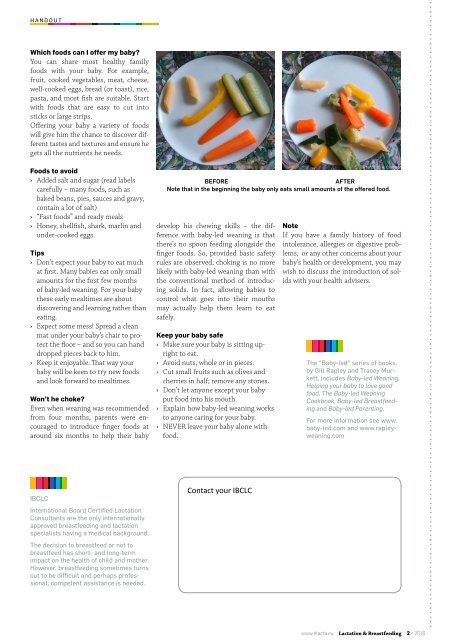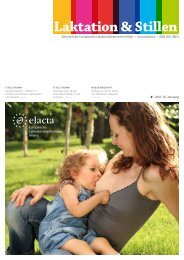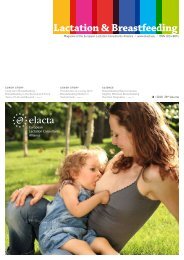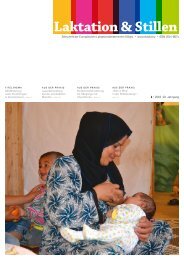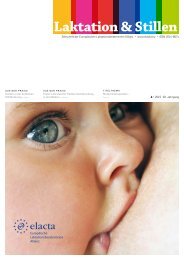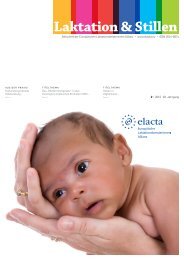Laktation_und_Stillen_2016-2 EN p1-8 web
Create successful ePaper yourself
Turn your PDF publications into a flip-book with our unique Google optimized e-Paper software.
HANDOUT<br />
Which foods can I offer my baby?<br />
You can share most healthy family<br />
foods with your baby. For example,<br />
fruit, cooked vegetables, meat, cheese,<br />
well-cooked eggs, bread (or toast), rice,<br />
pasta, and most fish are suitable. Start<br />
with foods that are easy to cut into<br />
sticks or large strips.<br />
Offering your baby a variety of foods<br />
will give him the chance to discover different<br />
tastes and textures and ensure he<br />
gets all the nutrients he needs.<br />
Foods to avoid<br />
› Added salt and sugar (read labels<br />
carefully – many foods, such as<br />
baked beans, pies, sauces and gravy,<br />
contain a lot of salt)<br />
› “Fast foods” and ready meals<br />
› Honey, shellfish, shark, marlin and<br />
<strong>und</strong>er-cooked eggs<br />
Tips<br />
› Don’t expect your baby to eat much<br />
at first. Many babies eat only small<br />
amounts for the first few months<br />
of baby-led weaning. For your baby<br />
these early mealtimes are about<br />
discovering and learning rather than<br />
eating.<br />
› Expect some mess! Spread a clean<br />
mat <strong>und</strong>er your baby’s chair to protect<br />
the floor – and so you can hand<br />
dropped pieces back to him.<br />
› Keep it enjoyable. That way your<br />
baby will be keen to try new foods<br />
and look forward to mealtimes.<br />
Won’t he choke?<br />
Even when weaning was recommended<br />
from four months, parents were encouraged<br />
to introduce finger foods at<br />
aro<strong>und</strong> six months to help their baby<br />
BEFORE<br />
AFTER<br />
Note that in the beginning the baby only eats small amounts of the offered food.<br />
develop his chewing skills – the difference<br />
with baby-led weaning is that<br />
there’s no spoon feeding alongside the<br />
finger foods. So, provided basic safety<br />
rules are observed, choking is no more<br />
likely with baby-led weaning than with<br />
the conventional method of introducing<br />
solids. In fact, allowing babies to<br />
control what goes into their mouths<br />
may actually help them learn to eat<br />
safely.<br />
Keep your baby safe<br />
› Make sure your baby is sitting upright<br />
to eat.<br />
› Avoid nuts, whole or in pieces.<br />
› Cut small fruits such as olives and<br />
cherries in half; remove any stones.<br />
› Don’t let anyone except your baby<br />
put food into his mouth.<br />
› Explain how baby-led weaning works<br />
to anyone caring for your baby.<br />
› NEVER leave your baby alone with<br />
food.<br />
Photos: © A. Cramer<br />
Note<br />
If you have a family history of food<br />
intolerance, allergies or digestive problems,<br />
or any other concerns about your<br />
baby’s health or development, you may<br />
wish to discuss the introduction of solids<br />
with your health advisers.<br />
The “Baby-led” series of books,<br />
by Gill Rapley and Tracey Murkett,<br />
includes Baby-led Weaning,<br />
Helping your baby to love good<br />
food, The Baby-led Weaning<br />
Cookbook, Baby-led Breastfeeding<br />
and Baby-led Parenting.<br />
For more information see www.<br />
baby-led.com and www.rapleyweaning.com<br />
IBCLC<br />
International Board Certified Lactation<br />
Consultants are the only internationally<br />
approved breastfeeding and lactation<br />
specialists having a medical backgro<strong>und</strong>.<br />
The decision to breastfeed or not to<br />
breastfeed has short- and long-term<br />
impact on the health of child and mother.<br />
However, breastfeeding sometimes turns<br />
out to be difficult and perhaps professional,<br />
competent assistance is needed.<br />
Contact your IBCLC<br />
www.elacta.eu Lactation & Breastfeeding 2 • <strong>2016</strong>


